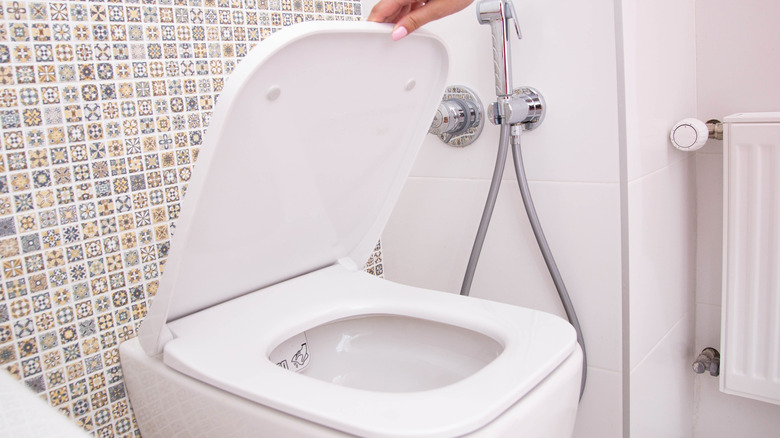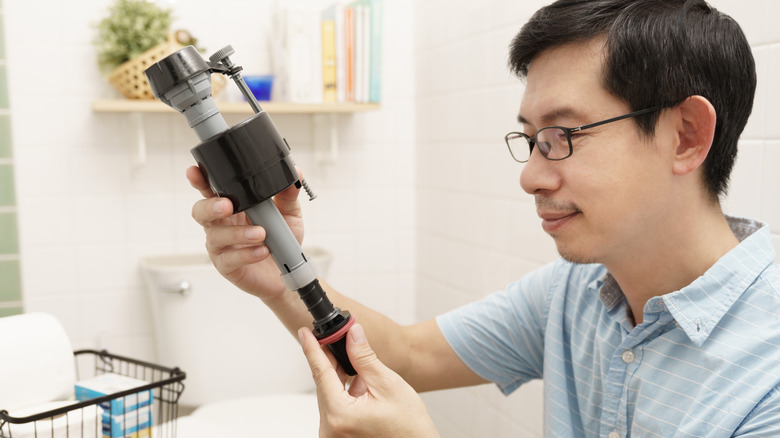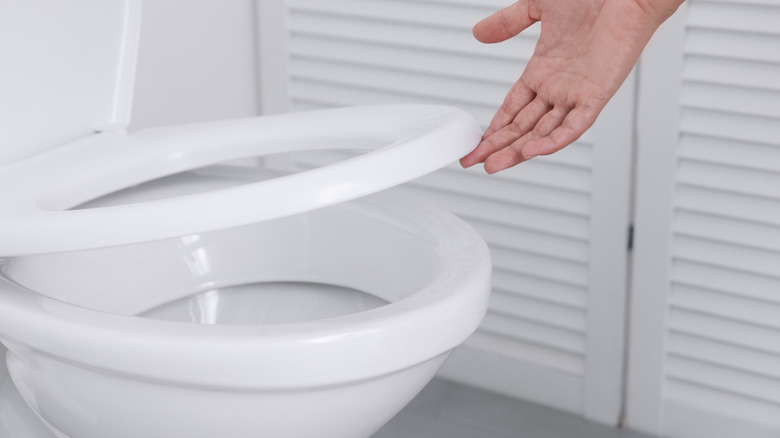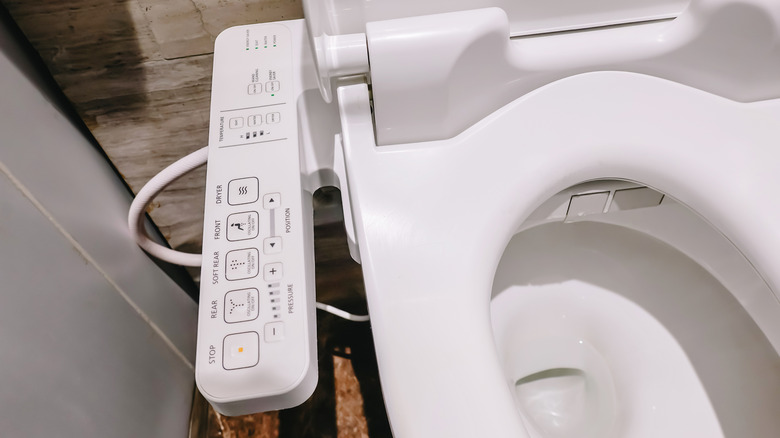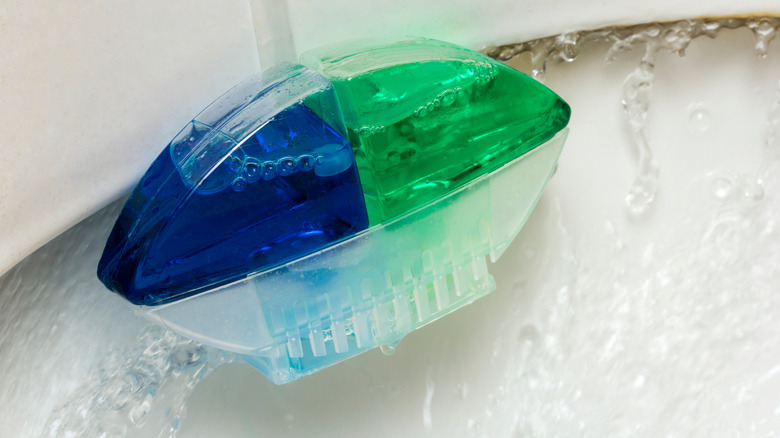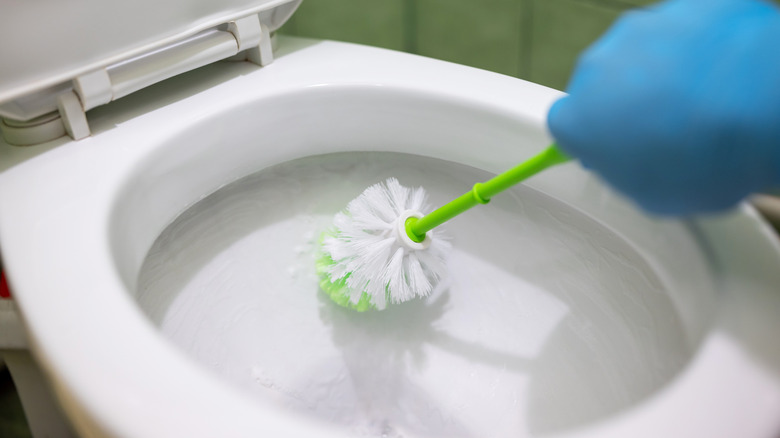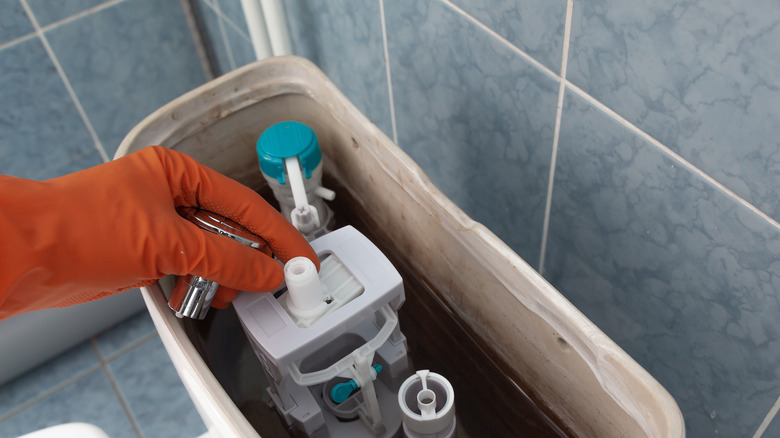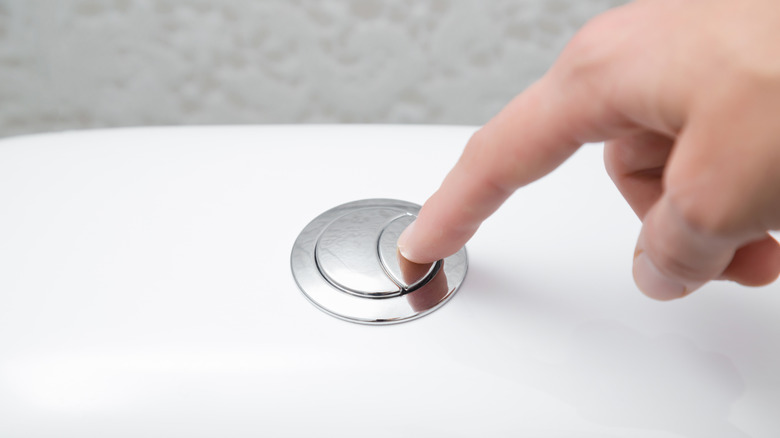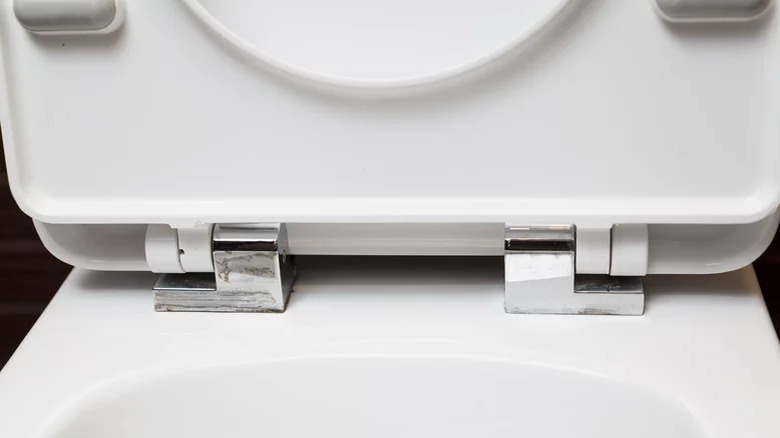11 Helpful Ways You Can Upgrade Your Toilet
We may receive a commission on purchases made from links.
You wouldn't exactly call the average toilet an object of great mystery. They are, for the most part, very simple devices, and after you've seen 100 or 1,000 nearly identical ones, it's easy to believe there's not a lot of room for improvement and innovation. But toilet manufacturers will find a way to make things more comfortable or more convenient for us if there's a competitive advantage in it, and there certainly is. Because of this, there are many ways to upgrade your toilet.
So, what are some interesting features that can upgrade your humble lavatory? Some are new innovations, some are expensive, and some are proprietary and so not available on every model. There are upgrades that will make cleaning them easier — such as antimicrobial coatings — while other enhancements focus on making them more aesthetically pleasing — such as models that hide their tanks inside the walls. Let's have a look at these hidden miracles of waste disposal and see what you might have been missing.
Replace your toilet's standard valve with a water-saving model
According to the EPA, toilets account for around 30% of your indoor water use. While you can't leave the bowl dirty, you might be wasting water with every flush. This could happen because the fill valve that controls how much water flows into the tank is set too high. Some valves allow you to adjust this level. However, if you want to maintain a powerful flush, you'll want to make sure enough water fills the bowl. Replacing your old component with a more efficient one, like the Fluidmaster High Performance Toilet Fill Valve, allows you to control both the tank and bowl levels to manage performance while saving water.
Replacing a toilet fill valve is quite simple, and you don't need any tools. You just need your new valve unit, a bucket or another small container, and a sponge or microfiber towel. The first step is to shut off the water supply to the tank, flush it to drain the water inside, and disconnect the supply line (catching any excess water in the bucket). Open the tank and use a sponge to soak up the excess liquid, and carefully remove the old fill valve. Then, install the new model and reconnect the supply line. Finally, you'll turn the water back on and adjust the settings.
Trade your standard toilet seat for a soft-close one
Soft-close toilet seats are known for their slow and quiet descent as they meet the bowl. The secret lies in their dampers and hydraulic hinges. The former softens the blow when the seats are shoved close, while the latter prevents it from slamming. They work in tandem to minimize noise and keep your kid's fingers from bearing the brunt of quick-closing seats. Plus, the lack of hard slams reduces the chances of your bowl developing cracks or the seat's hinges from coming loose. A few models are detachable, too, to help you clean the nooks and crannies better.
Their biggest advantage over fast-close seats is their smooth operation. You can conduct your business in silence without worrying about startling your kid or waking your spouse in the middle of the night. Although loud lid slams won't be an issue after installing a soft-close toilet seat, they are generally more expensive than regular ones. That being said, they tend to last longer due to less wear and tear over time. So, you stand to get a high return on your investment in the long run.
Install bidet toilet seats or go with handheld attachments
A substitute for toilet paper, bidets are a bathroom appliance that sprays water to cleanse your behind. Depending on your needs and budget, you can choose between a handheld attachment and a bidet toilet seat. Costing about $15 to $80, handheld attachments, like Arofa's Toilet Sprayer, come with a nozzle spray and are a good option if you're on a tight budget. You just need to connect them to your plumbing and mount them to your toilet's side or near your toilet paper.
On the flip side, full bidet toilet seats can be installed right on top of your current bowl. Their self-cleaning nozzle gently releases water to wash your intimate regions after you conduct your business. This hands-free operation can cost a bit more than a sprayer. Non-electric seats, like Brondell's Non-Electric Swash Ecoseat, are on the cheaper end. But you can only adjust the water pressure and the nozzle's position to your liking. However, electric seats like ToTo Washlet, come with a lot of bells and whistles. These higher tech options often have features like touchpads or remotes along with luxurious amenities like heated seats, a warm air dryer, and temperature control. A few high-end models even come with built-in deodorizers and voice commands. Both electric and non-electric versions are renter-friendly since they don't require permanent modifications.
Bidets are better for the environment than toilet paper and offer a better clean. They even reduce the risk of irritation since you won't be rubbing your sensitive areas with sheets of toilet paper. Plus, hands-free seats are particularly beneficial for people with limited physical movement. Not having to buy toilet paper regularly will also save you money in the long run.
Invest in toilet deodorizers to keep it smelling good
You know those awkward moments when you ask your partner not to use the bathroom immediately after you? Or, the time you had to hold your breath when your kid stank it up? With toilet deodorizers, these problems are solved. These products work around-the-clock to mask all foul odors and keep your bowl smelling pleasant with each flush. A few might even cleanse it, making you hate toilet cleaning a little bit less.
Toilet deodorizers are available in multiple styles, and you can pick one based on your preferences. For instance, hanging ones go over the rim of the bowl and are usually the most budget-friendly of the lot. Lysol's Automatic In-The-Bowl Toilet Freshener is a good option. However, remember to keep the lid closed and keep an eye on small children who might eat it. Or use tank tablets, like Vacplus Automatic Toilet Cleaner, if you want to keep your toilet clean and perfumed. You just drop it into the tank, and the concentrated cleaner rinses the bowl every time you flush for up to 15 days.
Swap your toilet's handle for a stylish and simple upgrade
Looking for a simple and stylish idea to spruce up your toilet? Swap its old handle with a gorgeous upgrade. Stick to simple designs, such as nickel, stainless steel, oil-rubbed bronze, and polished chrome pieces, for a classic look. Or, draw inspiration from your bathroom's fixtures to choose the right type of toilet handle for your decor. An easy way is to match the lever's color to your toilet paper holder or faucet. Or, look for something that's in line with the room's decor theme. For example, Kingston's Brass and Porcelain Handle will gel well with Victorian decor.
Whichever option you go for, ensure the lever's position, like front-, side, or angle-mounted, conforms to your current model. Once you have the desired handle, shut off the water supply, flush your toilet, and lift the tank's lid. Detach the old lever from the lift chain and grab a crescent wrench to remove the nut holding it in place. Loop the new handle through the hole, tighten the nut, and hook the chain in position. The last step is to put the lid back and turn on the water supply.
Create easier cleaning by adding nonstick and antimicrobial coatings
You've never wanted technology to do your work for you quite so much as when it's time to clean the toilet. It's no fun, but you have to keep your toilet looking clean and, more importantly, actually being clean. You can have both with almost no effort.
This is all about coatings that are applied to the ceramic surfaces of your toilet during the manufacturing process or when cleaning. A DIY coating that greases the skids, so to speak, promises to keep toilet bowls cleaner via a two-part spray-on polymer. Taking inspiration from pitcher plants — which are carnivorous flora with slippery hair-like structures that help trap insects — the spray coats ceramics with microscopic fibers, and then coats those fibers with a slippery material that helps keep things moving. This has the potential to both keep toilets cleaner and to save water. The coating is available for $15 and up from the official spotLESS website.
Antimicrobial coatings applied during manufacture are very common among most toilet brands. Copper- and silver-based coatings, along with less common zinc oxide and titanium dioxide, are fairly effective, but can wear away with time and flushes. You can buy coating products to replenish the coating or add it to a toilet that didn't originally come protected.
Ensure less malfunctions with flapperless flushes
Remember the last time you were sitting around thinking about your toilet's flapper, wishing you had some other option that's less prone to leaks and more prone to, you know, flushing stuff? Okay, maybe you haven't had this particular daydream, but maybe you should. Because in this wondrous age, you can have it all.
Flapper mechanisms are notoriously the part of toilets most prone to failure, and while no toilet failure is a good thing, the worst that will happen under most circumstances is excessive water use and a high water bill. More modern designs feature flapperless mechanisms that employ a fill valve far less prone to misbehavior. And if you aren't blessed with such a toilet, there's a good chance you can retrofit your toilet and get rid of the flapper. In fact, some early flapperless toilets will benefit from newer-generation fill valve mechanisms like this Glacier Bay and Niagra replacement on Amazon, which can refill your tank faster. Perhaps best of all, it's an easy DIY job that, in most cases, can be completed in less than an hour.
Save water with dual flush
By now, we've all seen and used push-button dual-flush toilets that can help save money by giving you a choice of flush intensity. The concept is as simple as can be: use the button designated for less water (it's often a smaller button, or has an icon indicating "less water" or "number one") to flush liquid waste, and the other button to dispose of solids.
This is often considered a feature only available with button-operated toilets, but you could also have the feature on your lever-actuated toilet. Rather than employing two push-buttons, these tend to have two levers that look like one at a glance. These might be a good choice in a household with children who can potentially be confused by buttons, or members who are used to levers. If you want to convert your old toilet to dual flush, you can pick up a kit at Lowe's for $35-75 that should do the trick.
Create a sleeker look with a tankless toilet
Some hidden features are hidden on purpose, and this one's a game-changer. Wall-mounted toilets are more flexible in terms of meeting code, more comfortable (for some, at least) by being installable at any height, and just generally sleeker by virtue of having their tanks concealed within the adjacent wall. And you're never going to have to clean that part, either.
These hidden-tank toilet models have a few advantages. Obviously, keeping the tank out of sight makes things look cleaner, and they certainly are easier to keep clean. They are also suitable for bathrooms in which space is tight, and for applications where you want to customize the seat's height. (Within code regulations, of course. Ahem.) And the keyword everyone values: legroom.
However, in-wall tanks can be expensive to install, always requiring minor construction, and sometimes fairly major effort to move wall studs, re-route water and electrical lines, and patch tile. It's one of the more involved upgrades you can make.
Create an easier clean with a skirted design
If you have a toilet designed for easy cleaning, you probably already know it, at least subconsciously. Many modern toilets have one-piece designs, which eliminate a nook that's difficult to clean properly and a joint that could possibly (if rarely) fail, resulting in a leak.
However, toilets with skirted trapways take that concept up a notch. The "skirting" is simply a smooth surface that hides the underlying pipes connecting the toilet bowl and the drain line. The end result is a smooth toilet design without the usual ridges and outlines. That means you can simply wipe it down on chore day without having to dip and curve to get accumulating dust. That alone can make the upgrade worth it for some folks. It also has a sleeker appearance thanks to its streamlined, uniform shape, elevating the look of your bathroom. And the best part? They typically cost the same as a regular toilet, with some models starting at $200.
Catch grime with a removable seat
Even if you have the simplest, smoothest toilet ever made, you'll still have one frustration to deal with: cleaning around the base of the seat, where it connects to the toilet. But there might be good news for you, so get the champagne ready — it's probably far easier than what you've been doing.
If you're like most people, champagne is the last thing you're thinking of when you clean around your toilet seat's hinges. You're probably thinking more of engineering ... conforming the shape of your cleaning tools to the impossibly small and oddly shaped areas in and around the juncture of toilet and seat.
If you ever considered removing the toilet seat, you probably bailed out after the thought of tracking down the right screwdriver and wrench. But if you upgrade to an easy-release seat, you'll no longer have to mess around with that. All you'll have to do is unclip the hinges from their connectors and slide the seat off, making cleaning a snap.
